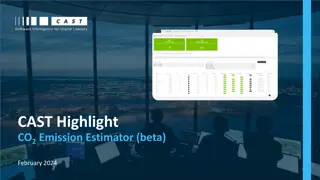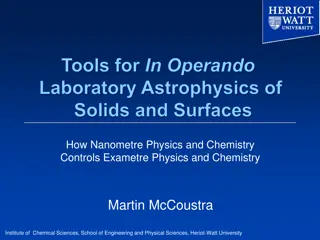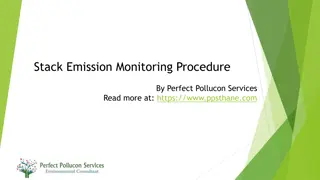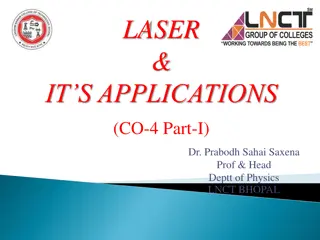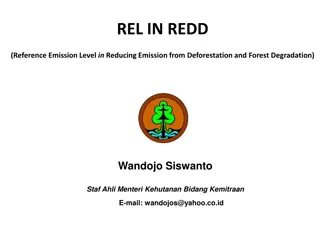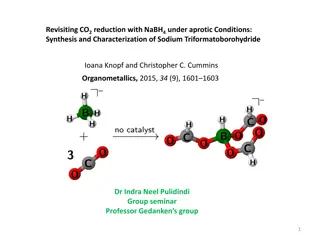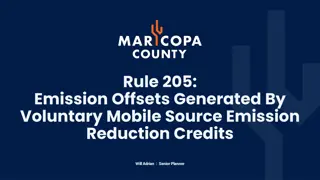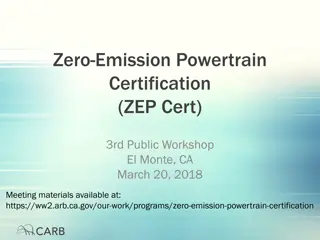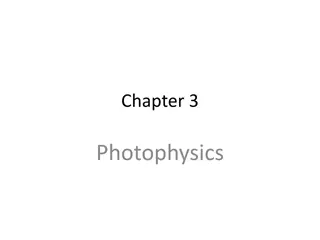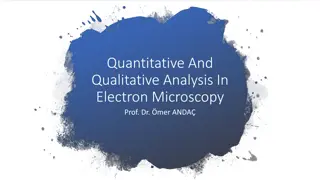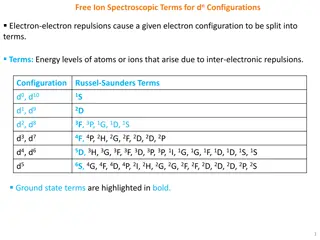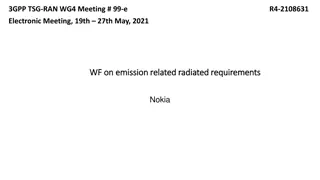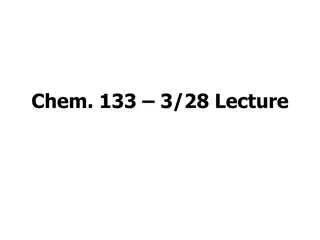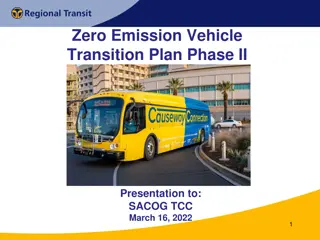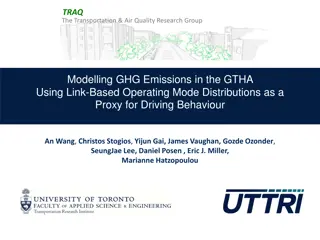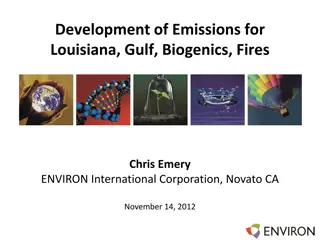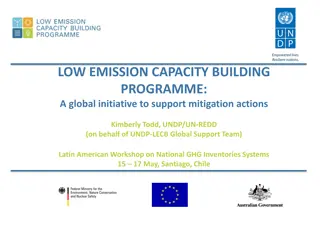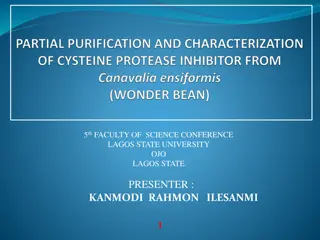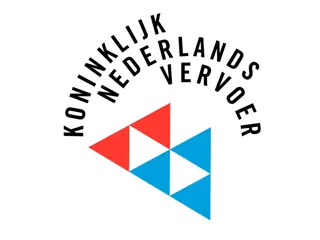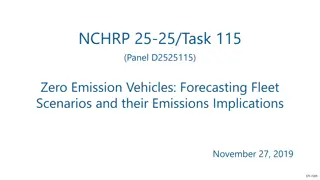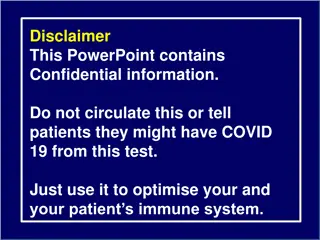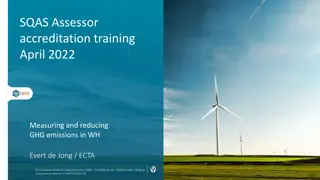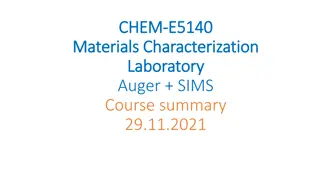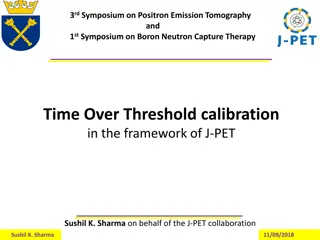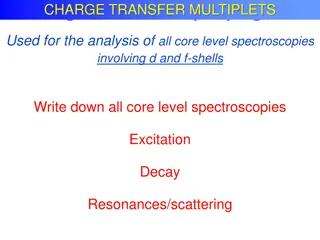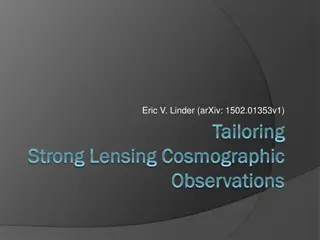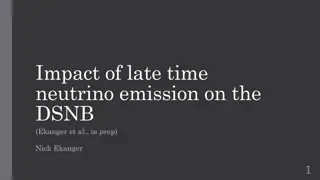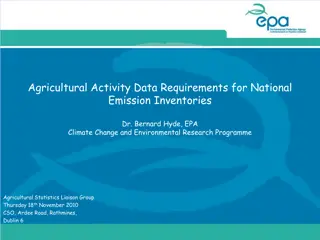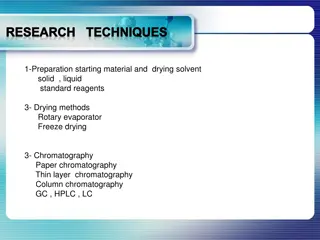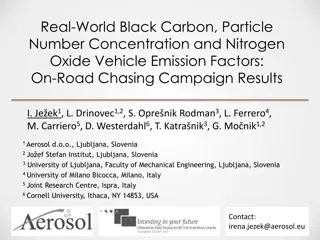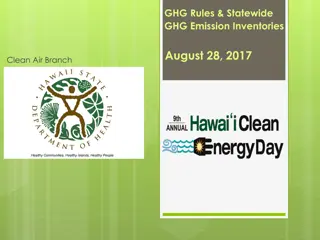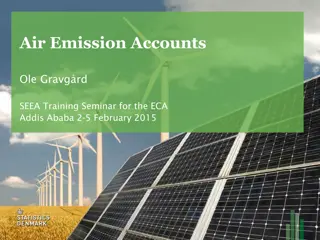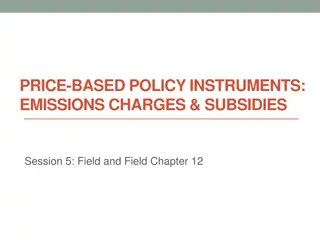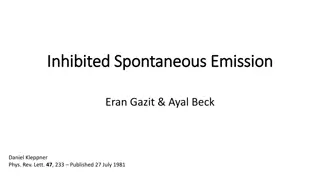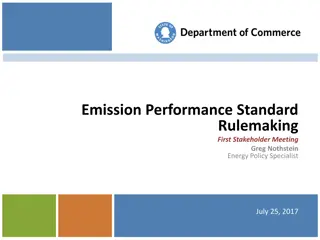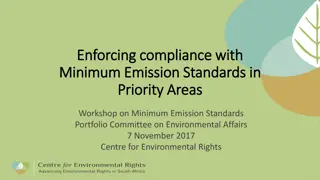Developing the CAST Highlight CO2 Emission Estimator (Beta) - February 2024
CAST Research Labs studied the impact of removing green deficiencies detected by CAST Highlight on CO2 emissions and energy consumption in custom software applications. The study led to a formula for estimating potential CO2 emission reductions, which was integrated into the new CAST Highlight CO2 E
0 views • 11 slides
Chemically-controlled Cosmos: Insights into Molecular Complexity in Astrophysical Environments
Delve into the intriguing world of the Chemically-controlled Cosmos, where spectroscopic observations reveal over 200 chemical species existing in gas and solid phases. From simple atoms and molecules to complex structures crucial for star formation and potential life seeding, explore the diverse en
8 views • 56 slides
Organometallic Chemistry III: Transition Metal Complexes and Homogeneous Catalysis
Explore the reactivity of transition metal complexes, including bond metatheses and various reactions. Learn about orbital considerations, synthesis, and spectroscopic properties of organometallic complexes. The course covers basics from AC1, focusing on ligands, electron counting, and MO diagrams.
5 views • 8 slides
Efficient Stack Emission Monitoring Procedure for Air Quality Control
Stack emission monitoring is crucial for industries to assess and reduce pollutants in exhaust air. This procedure involves tasks like measurement, testing, and analysis of flue gases. Sampling sites are selected strategically for accurate readings, and molecular weight and gas velocity are determin
1 views • 11 slides
Understanding Laser Technology: Principles, Applications, and Einstein's Coefficients
Exploring the fascinating world of lasers, this content delves into the principles governing laser technology, including the concept of stimulated emission by Einstein. It covers the characteristics of lasers, different types, and the significant contributions of pioneers in the field. The explanati
0 views • 14 slides
Understanding Reference Emission Level in REDD
REDD (Reducing Emission from Deforestation and Forest Degradation) involves a system for producing carbon credits, including steps like setting baseline emission levels, devising deforestation reduction strategies, monitoring changes, managing carbon credit sales, and distributing income. Organizati
0 views • 10 slides
Sodium Triformatoborohydride Formation via NaBH4-CO2 Reaction
Sodium triformatoborohydride, Na[HB(OCHO)3], is synthesized by reacting NaBH4 with CO2 under aprotic conditions. The choice of reductant is crucial for CO2 reduction methods, highlighting the role of NaBH4 as a cost-effective and reactive reducing agent for formate production. The exclusive formatio
1 views • 12 slides
Compliance Guide for Rule 205: Emission Offsets & Mobile Source Credits
Rule 205 outlines the process for generating emission offsets through voluntary mobile source emission reduction credits in Maricopa County. The rule-making process, state implementation plan submission, and permit conditions related to Rule 205 are discussed. The preparation for compliance includes
0 views • 7 slides
Understanding the Principle and Working of Semiconductor Lasers
Semiconductor lasers operate through absorption, spontaneous emission, and stimulated emission processes. Absorption of radiation causes electrons to jump to higher energy levels, leading to light emission. Spontaneous emission is when excited electrons return to ground state by emitting photons, wh
3 views • 17 slides
Zero-Emission Powertrain Certification Workshop Highlights
Workshop materials and agenda from the Zero-Emission Powertrain Certification 3rd Public Workshop held in El Monte, CA on March 20, 2018, discussing the ZEP Cert framework, applicability, testing, monitoring requirements, and more. The workshop aimed to accelerate the adoption of zero-emission techn
1 views • 24 slides
Understanding Photophysics: Emission and Luminescence Processes
Photophysics explores the emission and loss processes in luminescent phenomena, named based on the excitation mode of energy-rich species. Different types of luminescence include fluorescence, phosphorescence, and chemiluminescence. Bioluminescence in nature, such as in fireflies and dinoflagellates
0 views • 20 slides
Analysis and Applications of Electron Microscopy in Science Education
Explore the in-depth analysis of quantitative and qualitative techniques in electron microscopy as it relates to interactions with matter, instrumentation, specimen preparation, elemental analysis, and more. Delve into the electromagnetic spectrum, radiation effects on the human body, and spectrosco
0 views • 13 slides
Understanding Free Ion Spectroscopic Terms and Their Splittings
Dive into the world of free ion spectroscopic terms and their splitting in different ligand fields. Explore configurations, energy levels, and Orgel diagrams to grasp the complexities of electron-electron interactions.
0 views • 7 slides
Emission Requirements Discussion at 3GPP TSG-RAN-WG4 Meeting #99-e
Discussion at the 3GPP TSG-RAN-WG4 Meeting #99-e focused on emission-related radiated requirements for DL and UL in relation to adjacent channel protection in NR specifications. Various options and candidates for defining ACLR were explored, along with considerations for spurious emissions and OBUE
1 views • 5 slides
Introduction to Spectroscopic Instrumentation and Monochromators
Today's lecture covers spectroscopic instrumentation with a focus on monochromators. It delves into the components and performance measures of spectrometers, including wavelength discrimination filters, light detectors, and energy dispersive detectors. The dispersion of light through prisms and grat
0 views • 17 slides
Insights into Radio and X-ray Emission in Radio-Quiet Quasars
Radio galaxies are categorized as radio-loud or radio-quiet based on the presence of jets and lobes. Unlike radio-loud quasars, the nuclear radio emission in radio-quiet quasars does not originate from large-scale jets. Possible explanations include broad absorption lines, magnetically accelerated e
0 views • 15 slides
Zero Emission Vehicle Transition Plan Phase II Presentation to SACOG TCC
California Air Resources Board (CARB) mandated the transition to 100% zero-emission fleets by 2040 for all transit agencies, leading SACOG to roll out Zero Emission Bus (ZEB) programs. The ZEV Planning Phase II report details the introduction, garage concepts, ZEB transition, costs, and next steps i
0 views • 10 slides
Modelling GHG Emissions in Greater Toronto Area Using Link-Based Operating Mode Distributions
The Transportation & Air Quality Research Group's study focuses on generating a lifecycle emission inventory for transportation in the Greater Toronto Hamilton Area (GTHA). They aim to incorporate uncertainty in the emission inventory and quantify the impact of electric vehicles on total emissions.
0 views • 35 slides
Detailed Overview of Emissions Development in Louisiana
Emissions Processing System (EPS3) generates chemically speciated, gridded formats required by CAMx, with a focus on raw annual/ozone season county/parish-level emission inventory files and support data. Spatial and temporal profiles, along with cross-reference files, are essential for this work, co
1 views • 27 slides
Global Low Emission Capacity Building Programme Overview
The Low Emission Capacity Building Programme is a global initiative by UNDP aimed at enhancing capacities for designing and implementing Low Emission Development Strategies and national mitigation actions in various sectors. It includes components like GHG inventory management, NAMAs, LEDS, MRV, and
0 views • 12 slides
Characterization of Cysteine Protease Inhibitor from Canavalia ensiformis
Uncontrolled proteolysis due to cysteine proteases imbalance is crucial in numerous pathological conditions. Canavalia ensiformis, known as the wonder bean, shows potential as a source of cysteine protease inhibitor. The study aims to isolate and characterize the inhibitor from this plant. Methods i
0 views • 17 slides
Insights into the Dutch Coach Industry and Low Emission Zones
Discover the Dutch coach industry landscape, including the market share of KNV members, emission regulations in low emission zones, and challenges faced by coach companies like Leo Ringelberg Touringcars. Explore how KNV is advocating for cleaner coaches and addressing restrictions in important tour
0 views • 17 slides
Zero Emission Vehicles: Forecasting Fleet Scenarios & Emissions Implications
This research project, conducted by Louis Berger U.S. Inc. & Sonoma Technology Inc., explores the implications of adopting zero emission vehicles through forecasting fleet scenarios and estimating emissions reductions. The study assesses the potential increase in zero emission vehicle population, em
0 views • 42 slides
Optimizing Immune System Through Holistic Approach
This PowerPoint presentation contains confidential information on optimizing the immune system to enhance overall health. It outlines a holistic approach involving neurological organization, meridian testing, and spectroscopic emission to support well-being. The content emphasizes the importance of
0 views • 27 slides
Greenhouse Gas Emissions Management in Warehouse Operations
The SQAS Assessor accreditation training in April 2022 focused on measuring and reducing greenhouse gas emissions in warehouse operations. The content covers emission questions, scope of emissions, energy consumption examples, disaggregation of emissions, emission intensity calculation, and strategi
0 views • 17 slides
Overview of Auger Spectroscopy in Materials Characterization
Auger spectroscopy is a powerful technique used for materials characterization, involving the emission of Auger electrons to analyze the elemental composition of a sample. Named after Pierre Auger, this method provides valuable information about the surface properties of materials. The technique is
0 views • 24 slides
Symposium on Positron Emission Tomography and Boron Neutron Capture Therapy Time-Over-Threshold Calibration in J-PET
The 3rd Symposium on Positron Emission Tomography and 1st Symposium on Boron Neutron Capture Therapy focused on Time-Over-Threshold calibration within the framework of J-PET. The event outlined experimental details, event selection, results, and key features of the Jagiellonian Positron Emission Tom
0 views • 35 slides
Applications and Importance of X-ray Fluorescence Spectroscopy in Analytical Chemistry
X-ray Fluorescence Spectroscopy (XRF) is a vital analytical technique used for qualitative and quantitative analysis of elements based on their X-ray emission characteristics. Dr. Uma Sharma, a Professor at Vikram University, details various X-ray analytical methods, including X-ray emission, Auger
0 views • 21 slides
Core Level Spectroscopies in Charge Transfer Multiplet Program
Core level spectroscopies in the Charge Transfer Multiplet Program are essential for analyzing d and f-shells in various spectroscopic techniques involving excitation, decay, resonances, and scattering. These spectroscopies include X-ray spectroscopies, electron spectroscopies, and resonant spectros
0 views • 69 slides
Tailoring Strong Lensing Cosmography Observations
The exploration of cosmography involves mapping the general features of the universe to understand its large-scale geometry and kinematics. This study delves into measuring time delay distances, optimizing spectroscopic follow-up, and addressing systematics such as redshift distribution and model sy
0 views • 23 slides
Late-Time Neutrino Emission Impact on DSNB Study
Explore the implications of late-time neutrino emission on the Diffuse Supernova Neutrino Background (DSNB) through core collapse supernovae simulations. The research delves into the dynamics of neutrino emission in different phases of supernova events and its relevance to understanding the DSNB.
0 views • 15 slides
Agricultural Emission Inventory Data Reporting Requirements
This presentation discusses the data requirements for national emission inventories in the agricultural sector, covering greenhouse gas inventories, air pollutant inventories, National Inventory Reports, Large Combustion Plant Directive, National Emission Ceilings Directive, livestock emissions, and
0 views • 13 slides
Essential Techniques in Chemical Research
Learn about key research techniques in chemistry including preparation methods, drying techniques, chromatography, spectroscopic techniques, and specific solvents used. Understand the importance of starting material preparation, drying reagents such as calcium chloride and molecular sieves, and how
0 views • 15 slides
Real-World Black Carbon & Nitrogen Oxide Vehicle Emission Factors Study
This study presents real-world data on black carbon (BC) and nitrogen oxide (NO) vehicle emission factors gathered through on-road chasing campaigns. The research explores the influence of dilution and vehicle performance on emission factor calculations, with a focus on measuring emissions from vehi
0 views • 13 slides
Hawaii Statewide Greenhouse Gas Emission Rules Overview
The Hawaii Statewide Greenhouse Gas (GHG) Emission Rules implemented by Act 234 in 2007 aim to limit statewide GHG emissions to 1990 levels by 2020. The rules include setting emission caps for stationary sources, conducting annual evaluations to track progress, and reporting GHG inventories regularl
0 views • 9 slides
Understanding Air Emission Accounts and Bridge Tables
Flows of air emissions, including gaseous and particulate substances released into the atmosphere, are recorded in Air Emission Accounts following specific guidelines and considerations. Bridge tables play a crucial role in reconciling differences between national economy totals and emission invento
0 views • 18 slides
Understanding Emission Charges for Environmental Policy
Explore the concept of emission charges as a policy instrument, where firms pay charges for every unit of effluent discharged to reduce emissions. The regulator sets the price to achieve efficient emission levels. Learn about setting charges in competitive environments, total abatement costs, and th
0 views • 18 slides
Exploring Inhibited Spontaneous Emission in Physics
The study delves into inhibited spontaneous emission in physics, focusing on the phenomena, experimental setups, and effects like the Purcell effect. It discusses using waveguides and Rydberg atoms for this purpose, as well as the density of modes and states in free space and cavity configurations.
0 views • 16 slides
Washington State Emission Performance Standard Rulemaking Stakeholder Meeting Overview
This document provides detailed insights into the first stakeholder meeting regarding the Emission Performance Standard Rulemaking in Washington State. It covers key agenda items, reviews of RCW 80.80 GHG Emission Performance Standard, definitions related to CCCT and baseload electric generation, an
0 views • 19 slides
Enforcing Compliance with Minimum Emission Standards in Priority Areas Overview
Workshop on the enforcement of minimum emission standards in priority areas, focusing on compliance requirements, challenges faced by key industry players like Eskom and Sasol, and the process of seeking postponements for meeting standards. Detailed insights into the regulatory framework, stakeholde
0 views • 20 slides
